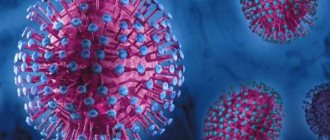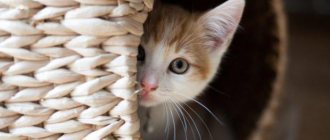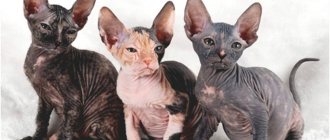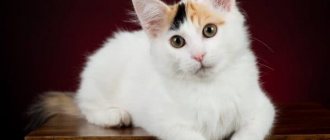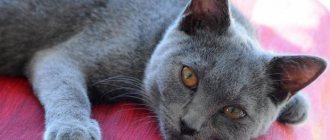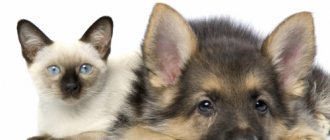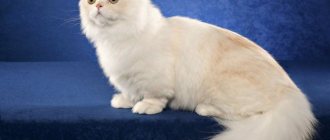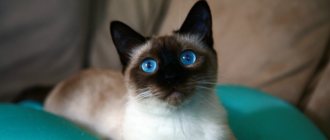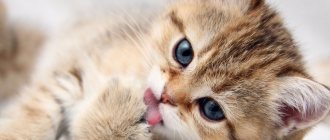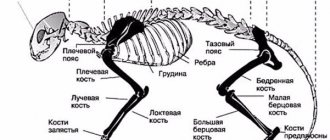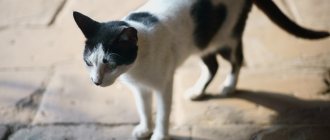Swallowing disorder is called dysphagia. This condition occurs in cats of all ages. In some cases, a cat cannot swallow a piece of food because it hurts. The pet's head twitches to force food to slide into the esophagus.
In other situations, swallowing becomes difficult due to paralysis or blockage of the throat. What are the causes of dysphagia? In what cases is there a threat to life? When is urgent veterinary care required? This article answers the questions raised.
Types of dysphagia
Fights cause dysphagia.
Swallowing disorders are divided into anatomical and functional. Morphological dysphagia can be congenital or acquired due to injury. Functional ones develop as a result of inflammatory or neurological diseases.
Based on localization, the following types of disorders are distinguished:
- Oral: The animal is unable to grasp food or form a bolus using the tongue and mouth. The cat chews for a long time, shaking its head so that the food falls into the throat.
- Pharyngeal: the relationship with the swallowing and gag reflexes is disrupted. Some of the food is regurgitated and ends up in the nasal passages. If the larynx becomes blocked, the pet dies from suffocation.
- Esophageal or esophageal. Food gets stuck in the esophagus and does not enter the stomach. A cough occurs, causing vomiting. The animal is starving and quickly loses weight.
Causes of swallowing disorders
Gingivitis
The swallowing process is disrupted under the influence of the following pathogenic factors:
- Mechanical: occur when a foreign object is inserted into the soft tissues of the mouth or the food tube is blocked. An embedded fish bone causes pain and interferes with the act of swallowing. A curious pet plays with small parts of toys or devices scattered on the floor, swallows them and blocks the lumen of the pharynx or esophagus.
- Traumatic: damaged soft tissues become inflamed and swollen, pain or narrowing of the food passage due to a formed scar prevents swallowing.
- Congenital: anatomical abnormalities prevent the normal passage of the food coma. Most often they occur during spontaneous selection, when mating partners are not selected taking into account pedigrees.
- Errors in feeding , in which food particles are retained on the gums. Plaque occurs, tartar forms, and gingivitis develops. The act of swallowing becomes painful.
- Inflammation of the lymph nodes due to hypothermia from frozen food, burns that are too hot, and infectious diseases.
- Formation of ulcerative defects of the mouth as a result of calicivirus infection.
- Paralysis of the masticatory muscles due to tick-borne or viral infection, poisoning, autoimmune processes.
- Swelling of the pharynx under the influence of irritating factors
- Traumatic brain injuries.
- Tumors.
Be sure to read:
The cat doesn’t eat, only drinks water, is lethargic: reasons for what to do if he refuses to eat and sleeps
Clinical symptoms and diagnosis
With calcivirosis, problems occur with swallowing due to ulcers on the tongue.
Dysphagia can be suspected based on the following pathological symptoms:
- profuse salivation with or without blood;
- cough and regurgitation after feeding;
- gagging;
- chewing food on one side of the jaw if dental disease has occurred on the other;
- halitosis - stench from the mouth;
- crusts around the nose;
- picky eating;
- exhaustion;
- curvature of the neck;
- head shaking;
- plaintive meowing for no apparent reason.
The initial diagnosis is made by the cat owner if he notices at least 2 or 3 of the listed pathological signs. The cause of the disease is determined based on a clinical examination of the medical history and additional studies prescribed by a veterinarian.
Complete absence or partial hearing impairment
The hearing organ for a cat ranks second in importance after vision. With the help of hearing, a cat navigates in space, hunts and recognizes impending danger. Degeneration of the inner ear leaves the cat completely defenseless. Deafness is most often caused by ear parasites; due to severe itching, the cat can scratch the ear and injure the auricle. You should maintain hygiene and clean your ears regularly to remove accumulated wax. If the disease develops into otitis and it is not cured in time, the animal may become deaf.
How do you know if your cat has hearing problems? She will meow much louder, lose orientation in space, often look around, scratch her ears with her paw, look timid, and her usual reaction to the call for food will also change.
Treatment and prevention
Feeding through a nasoesophageal tube
Treatment consists of eliminating the cause of the disease and diet therapy.
For conservative treatment, medications of the following groups may be needed:
- antibiotics;
- immunomodulators;
- anti-inflammatory corticosteroid drugs;
- external wound healing agents.
Since swallowing is difficult, food is served in liquid form; if it is refused, it is forcibly administered through a nasoesophageal tube.
Restorative procedures involve parenteral administration of a mixture of electrolytes and detoxifiers, and, if necessary, water-soluble vitamins.
Surgical treatment is used to remove a foreign body, remove a diseased tooth or tumor. Congenital anomalies, as well as certain traumatic injuries, cannot be treated.
Teeth cleaning
Prevention consists of the following actions:
- Complete nutrition with prepared food of at least premium class. If plaque forms, use special food to remove food debris from the teeth and gums.
- Use natural cat toothpaste and brush.
- Do not treat your pet to fish with bones that could get stuck in the mouth or throat.
- Do not scatter small parts of toys or devices on the floor that your pet could swallow.
- Do not offer frozen or too hot treats.
- Vaccinate your pet in a timely manner in accordance with the vaccination plan.
- Use insectoacaricidal agents to protect the animal from arthropods.
- Carefully select pairs for mating. Eliminate the possibility of inbreeding.
Be sure to read:
What should you do if your cat develops a lump at or near the injection site after vaccination? When does a tumor become oncology?
My cat has toothache: sure signs
Contents hide
Since childhood, we have all been afraid of the dentist's chair. And even now, during a period of unprecedented technological progress, every time we shy away fearfully, we postpone the visit until the last minute - maybe it will hurt and calm down. But it’s not for nothing that toothache inspires awe: as they say, if it’s really hot, you’ll rush to the doctor.
And what a subtlety this is. We know very well what toothache is. And for our part, we take all preventive measures: we brush our teeth twice a day, buy branded toothbrushes and toothpastes from the best manufacturers. And, despite all our tricks, we still have to visit the dentist at least once a year. Try it, find a person who doesn’t have a single filling! Now let's look at our pet cats. Fellow authors have broken more than one keyboard while writing articles about the benefits of brushing teeth for purrs. But are there any of our readers who put a toothbrush in their pet’s mouth twice a week? However, this does not mean that cats do not have dental problems. Veterinary dentists also exist for a reason. When you and I get a toothache, we immediately drop everything we’re doing. But the purrs endure to the last, although they need help no less. Our article contains alarming symptoms and signs of dental problems in cats. Long live dentists!
Bad breath. A bad odor from a cat's mouth is considered almost the norm, especially when it comes to older animals. However, a bad smell (whether in people or animals) never occurs on its own; it always indicates a problem. These include rotting teeth, sore gums, and even problems with the digestive system. Hence the advice: as soon as you notice an unpleasant odor from your pet’s mouth, do not delay a visit to the veterinarian. Moreover, as you understand, you should examine not only the oral cavity.
Chewing on one side. Let us remember ourselves again: having felt pain and discomfort on one side, we instinctively begin to chew food on the other. Of course, the time and quality of chewing food increases dramatically. You will agree, it is impossible not to see and not notice this sign. Usatik is experiencing obvious difficulties - urgently see a doctor.
The cat became sloppy. In general, these animals are considered clean. Dirt around bowls is the exception rather than the rule. And suddenly everything changes: the cat is eating, but the food seems to be falling out of her mouth. Everything is explained simply: the animal takes food into its mouth, but cannot chew it, press it with its teeth or gnaw it - the pain interferes. And part of the food is inevitably lost and falls to the ground.
Swallowing food whole. Dry commercial food usually comes in small kibble to make it more convenient for cats. But the purrs still prefer to chew it, and with benefit for business. Large pieces are notoriously difficult to swallow. But here’s the problem: the appetite does not disappear, the bowl is filled with food, and toothache prevents you from enjoying food. Cats follow the path of least resistance - that is, they swallow food without chewing.
Increased salivation. During the acute period, the salivary glands, as a rule, begin to work at full capacity. You notice that your pet has become “drooling”: drooling while eating, during sleep, and while resting. If such oddities have never been observed in an animal, immediately show it to a veterinarian.
Loss of appetite. In general, this is a complex and multifaceted question; a cat can lose interest in food for many reasons. Still, keep a close eye on your pet. He seems hungry, he begs, but you don’t refuse, you generously offer various treats, but the animal is afraid to approach them - most likely, he has problems with his teeth. Perhaps a tooth has broken, an abscess is developing somewhere - we can only guess about the real reasons. To somehow feed the unfortunate animal, offer a bag of wet soft food. And don't delay your trip to the vet. However, another option is fundamentally possible - the tailed one simply wants to taste something unusual. But we will draw such a conclusion only after examination by a doctor.
Try to examine your pet. Cats are extremely reluctant to open their mouths on command and allow them to be thoroughly explored. And yet, if you have a certain skill, you should try. An attentive owner will easily detect inflamed gums, broken teeth, tartar, etc.
And yes: fellow authors are absolutely right to tap their fingers on their keyboards. Brushing the teeth of your mustachioed pets is not only useful, but actually necessary. Get started now.
Material used : Indications That Your Cat's Teeth Are Bothering Them. Source and photo: pets4homes.co.uk
